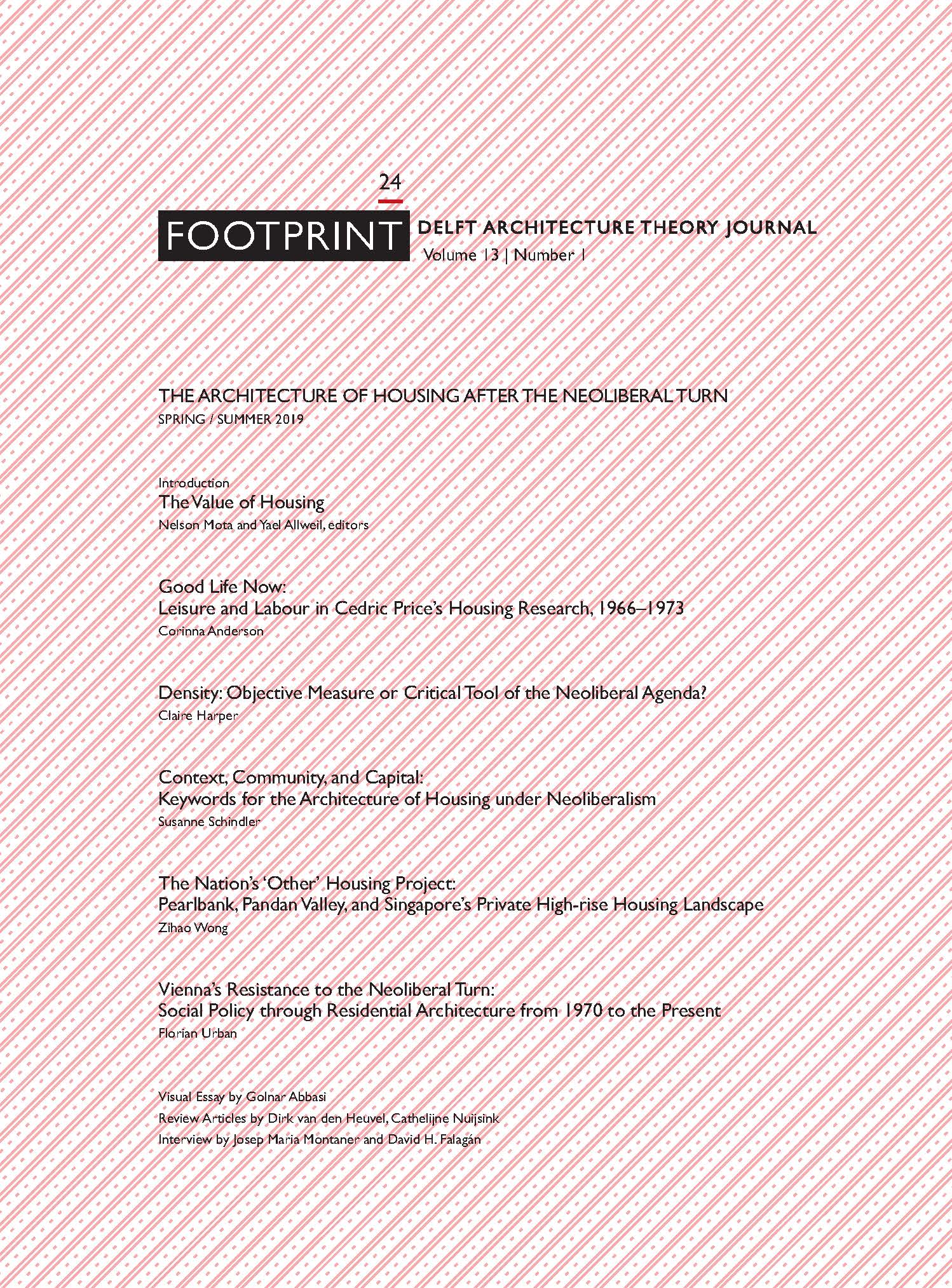Context, Community, and Capital
Keywords for the Architecture of Housing under Neoliberalism
DOI:
https://doi.org/10.7480/footprint.13.1.3791Abstract
This essay focuses on the language architects use to navigate the intersection of architecture, housing, and neoliberalism. Schindler argues that terminology plays a powerful role in allowing architects to avoid the socio-economic assumptions embedded in their work. Schindler traces the emergence, evolution, and codification of two such terms, ‘context’ and ‘community’, and how they have frequently been conflated. She shows how they were central to New York City’s gradual shift from welfare-state to neoliberal housing policies between the mid-1960s and the present day by connecting them to a third key term, ‘capital’. The vest-pocket housing plan developed for the South Bronx as part of the federal Model Cities programme serves as a case study. In the Bronx, the triangulation of community, context, and capital led to new development models, as well as new housing typologies, including the large-scale rehabilitation of existing tenements and small-scale new construction of row houses. The resulting shift in architectural discourse, and the codification of these practices in zoning and tax laws, have remained in force in New York City to this day.
References
Angotti, Thomas New York for Sale: Community Planning Confronts Global Real Estate. Cambridge, Mass.: MIT Press, 2008.
Awan, Nishat, Tatjana Schneider and Jeremy Till. Spatial Agency: Other Ways of Doing Architecture. Abingdon: Routledge, 2011.
Bagli, Charles. “Affordable Housing Program gives Tax Break to Developers.” New York Times, April 10, 2017.
Bloom, Nicholas Dagen and Matthew Gordon Lasner, eds. Affordable Housing in New York: The People, Places, and Policies That Transformed a City. Princeton: Princeton University Press, 2016.
Citizens Housing and Planning Council. “The Envelope Conundrum.’’ 2014, http://chpcny.org/2014/06/building-envelope-conundrum/
Cohen, Stuart. "Cultural Context/Physical Context: Including It All." Oppositions 2 (January 1974): 1–40.
Davidoff, Paul. “Advocacy and Pluralism in Planning.’’ Journal of the American Institute of Planners 31, no. 4 (1965): 331-338.
Erickson, David J. The Housing Policy Revolution: Networks and Neighborhoods. Washington, D.C.: The Urban Institute Press, 2009.
Fishman, Robert. “The Global Crisis of Affordable Housing: Architecture Versus Neoliberalism.’’ AD (Architectural Design) Housing as Intervention: Architecture towards Social Equity, edited by Karen Kubey. Chichester: Wiley (July 2018): 22–29.
Forty, Adrian. “Context.” In Words and Buildings. Oxford: Thames and Hudson, 2000: 132–135.
Goldstein, Brian. The Roots of Urban Renaissance: Gentrification and the Struggle Over Harlem. Cambridge: Harvard University Press, 2017.
Kocka, Jürgen. Capitalism: A Short History. Translated by Jeremiah Riemer. Princeton: Princeton University Press, 2016.
Kockelkorn, Anne. “A Sample Atlas.” In Housing after the Neoliberal Turn, edited by Stefan Aue et al. Berlin: Spector Books & HKW, 2015: 59–115.
Krivy, Maros and Tahl Kaminer, eds. Footprint 13. The Participatory Turn in Urbanism (Autumn 2013), https://journals.open.tudelft.nl/index.php/footprint/issue/view/386.
McQuirk, Justin. Radical Cities: Across Latin America in Search of New Architecture. London/New York: Verso 2015.
Moody, Kim. From Welfare State to Real Estate: Regime Change in New York City, 1974 to the present. New York: New Press, 2007.
Municipal Art Society. “History of 421a.” http://www.mas.org/urbanplanning/421a/history/, accessed August 8, 2016.
n.a. “Kennedy offers Plan on Ghettos.” New York Times. May 16, 1966.
n.a. “The Infill Housing Program, 1968–1973.” Boston TV News Digital Library, n.d. http://bostonlocaltv.org/blog/2011/09/the-infill-housing-program-1968-1973.
New York City Department of City Planning. “Evolution of ULURP, Step 5: Uniform Land Use Review Procedure (ULURP).’’ http://www1.nyc.gov/site/planning/applicants/applicant-portal/step5-ulurp-evolution.page, accessed June 8, 2016.
New York City Department of City Planning. “Zoning for Quality and Affordability.” www1.nyc.gov/site/planning/plans/zqa/zoning-for-quality-and-affordability.page, accessed June 7, 2016.
New York City Housing Development Administration. People and Plans: Vest Pocket Housing, The First Step in New York's Model Cities Program. July 12, 1967.
New York City Planning Commission. Zoning for Housing Quality. September 1975 (BYDCP 75-16).
New York City Planning Commission. Report N 870385A, N 870197A. June 17, 1987.
New York State Temporary Charter Revision Commission for New York City. Report on Model Cities. New York: November 1973.
Newman, Oscar. Defensible Space: Crime Prevention through Urban Design. New York: Macmillan, 1972.
Parry, Eric. Context: Architecture and the Genius of Place. Chichester: Wiley, 2015.
Philips-Fein, Kimberly. Fear City: New York's Fiscal Crisis and the Rise of Austerity Politics. New York: Henry Holt, 2017.
Schindler, Susanne. “1966 Can Be the Year of Rebirth for American Cities.” San Rocco 14: 66 (April 2018): 100–109.
Schindler, Susanne. “Model Conflicts.” e-flux architecture (July 2018), https://www.e-flux.com/architecture/structural-instability/208704/model-conflicts/
Schneider, Benjamin. “CityLab University: Inclusionary Zoning.” CityLab, July 17, 2018, https://www.citylab.com/equity/2018/07/citylab-university-inclusionary-zoning/565181/
Simmons, Lynda. “Toward a Theory of the Environment.” Journal for Architectural Education 29, no. 4 (1976): 18–19.
Spertus, Juliette and Susanne Schindler. “Co-op City and Twin Parks: Two 1970s Models of Middle-Class Living in the Bronx.” In Middle-Class Housing in Perspective, edited by Gaia Caramellino and Federico Zanfi. Bern: Peter Lang, 2015: 167–190.
Stein, Samuel. Capital City: Gentrification and the Real Estate State. London/New York: Verso 2019.
Task Force on Metropolitan and Urban Problems, Robert C. Wood, Chairman, Report of the Task Force for Metropolitan and Urban Problems, November 30, 1964.
Thadani, Dhiru A. and Peter J. Hetzel, eds. The Architecture of Community: Leon Krier. Washington, D.C.: Island Press, 2005.
von Hoffman, Alexander. “Calling upon the Genius of Private Enterprise: The Housing and Urban Development Act of 1968 and the Liberal Turn to Public-Private Partnerships.” Studies in American Political Development 27, no. 2 (2013): 165–194.
Woodsworth, Michael. Battle for Bed-Stuy: The Long War on Poverty in New York City. Cambridge: Harvard University Press, 2016.
Additional Files
Published
Issue
Section
License
- Authors retain copyright and grant the journal right of first publication with the work simultaneously licensed under a Creative Commons Attribution License that allows others to share the work with an acknowledgement of the work's authorship and initial publication in this journal.
- Authors are able to enter into separate, additional contractual arrangements for the non-exclusive distribution of the journal's published version of the work (e.g., post it to an institutional repository or publish it in a book), with an acknowledgement of its initial publication in this journal.




